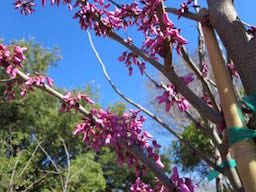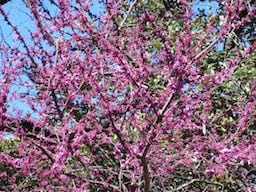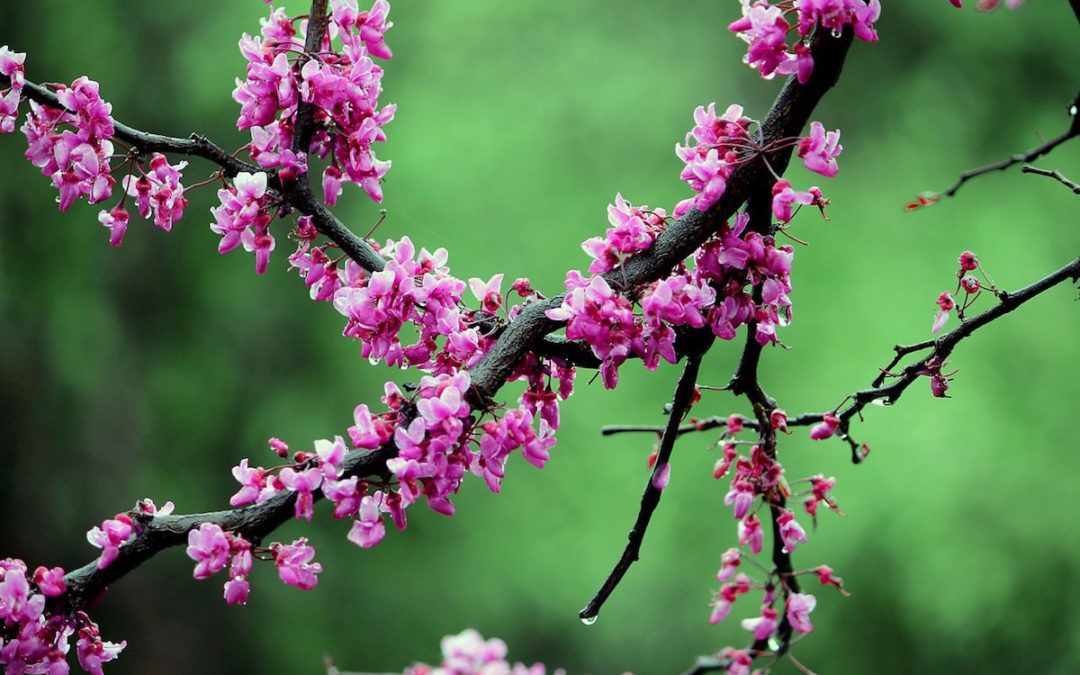One sure sign that spring and warmer weather are on the way in San Antonio is when the magenta buds of Texas redbuds pop open. One day you are looking at what looks like a bare tree, and the next day there is an explosion of color that could rival any Technicolor hue in a Dr. Seuss movie! Redbuds are a welcome sight after a period of gray winter days. Take a look at why Texas redbuds are a favorite here in San Antonio and at Rainbow Gardens


Texas Redbuds in San Antonio Landscapes
Like one of our other favorite spring bloomers, the Texas Mt. Laurel, the Texas Redbud is considered a small tree, and/or large shrub. This Texas native is a deciduous specimen that is used to our alkaline soils. The Texas Redbud has a good tolerance to drought and heat, once it has been thoroughly established.
Texas redbuds attract native pollinators with their nectar-filled, brilliantly hued blooms. It is also a larval host for Henry’s Elfin butterfly. The profuse blooms run the entire length of limbs producing a truly show-stopping effect. Green, glossy, heart-shaped leaves follow the blooms and fill out the tree until fall when they turn red or gold before fluttering to the ground for winter. Attractive, purplish-red seedpods develop and stay throughout winter.
In our area, Texas redbuds grow to mature heights of about 15 -20 feet depending on growing conditions. Many landowners in San Antonio plant their Texas redbuds in the vicinity of a larger, evergreen tree, as the Texas redbuds prefer the dappled shade provided especially during our hot summer months. If planted as lone specimens, offer your trees an area that receives morning sun and part shade in the afternoon. If planting multiple redbuds, give them a berth of about 20 feet between them.
Make sure your sun to part shade planting site is an area that drains well, as Texas redbuds don’t like wet feet. For this reason, it is always recommended that you do not plant your redbuds where they would receive the same irrigation that you offer your turf. Texas redbuds won’t need quite as much water once established. Texas redbuds are also one of the coupon eligible plants on the SAWS WaterSaver Landscape program due to its low water usage.
Follow the correct steps for planting trees, digging a hole only as deep as the root ball, but twice as wide. Once you’ve placed your redbud in the hole, backfill the hole with some compost mixed in to the native soil you pulled out when digging. Add a layer of 3”-4” of mulch, taking care to make sure the mulch is not piled directly next to the trunk. Create a berm around the trunk for easy watering. Let a slow trickle from a hose fill up the berm for a good deep soak.
Texas redbuds don’t really need pruning unless you have a damaged or broken branch, or if you want to prune while young to develop a more uniformed shape. Personally I prefer the natural look. Pruning tips can be found here.
Take some time to get more familiar with Texas redbuds. Once the end of February rolls around and you see them strutting their stuff, I bet you’ll wish you had one. Spring is on the way, celebrate with one of its best early bloomers!
The Happy Gardener, Lisa Mulroy


Hello! Does the forest pansy fare better than the eastern redbud in direct afternoon sun? I’m looking for something that gets a little larger than the eastern redbud, tops out 20-35 feet, and can handle full afternoon sun.
If not the forest pansy redbud do you have another suggestion?
Thanks!
We have found the Forest Pansy redbud to do fin in afternoon sun. In extremely hot weather the leaves will turn green. They will need a little more water than a Texas Redbud, so keep that in mind. I would suggest waiting until temps cool off in fall before planting any tree or shrub. Anyone planting in this heat will need to be extremely careful when handling the rootball.
Hello! Today is March 26th. Is it too late to plant a forest pansy red bud?
Hi Kathy,
It is not too late, but it is best to finish this task as soon as possible. The longer we wait to plant in spring, the closer we get to summer and it is difficult to get roots established through the heat of summer.
How much are your redbud trees
We currently have 5, 7, 10, 15, 25 gallons in stock ranging in price from $59.99 – $299.99. Varieties and sizes may vary at each location.